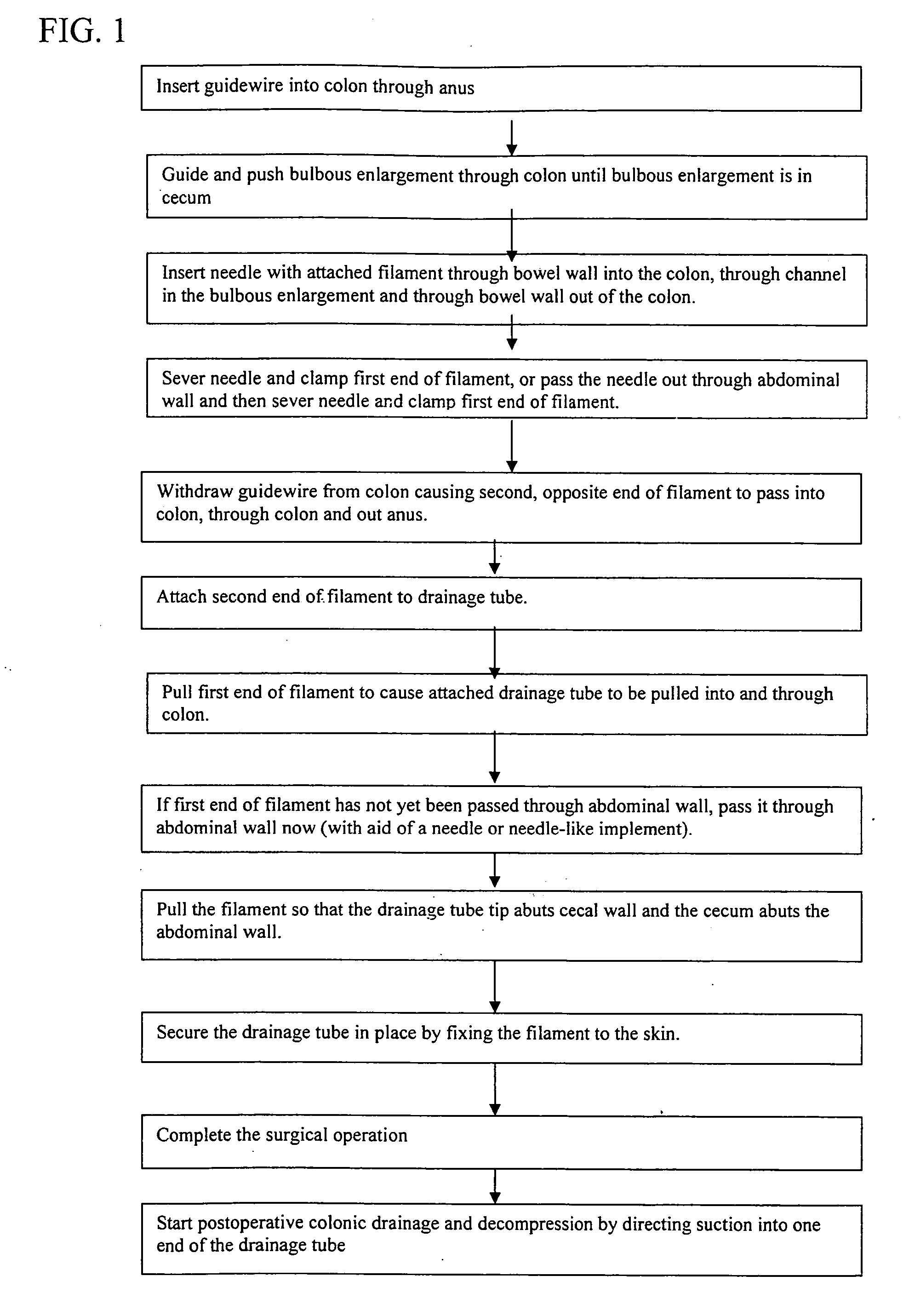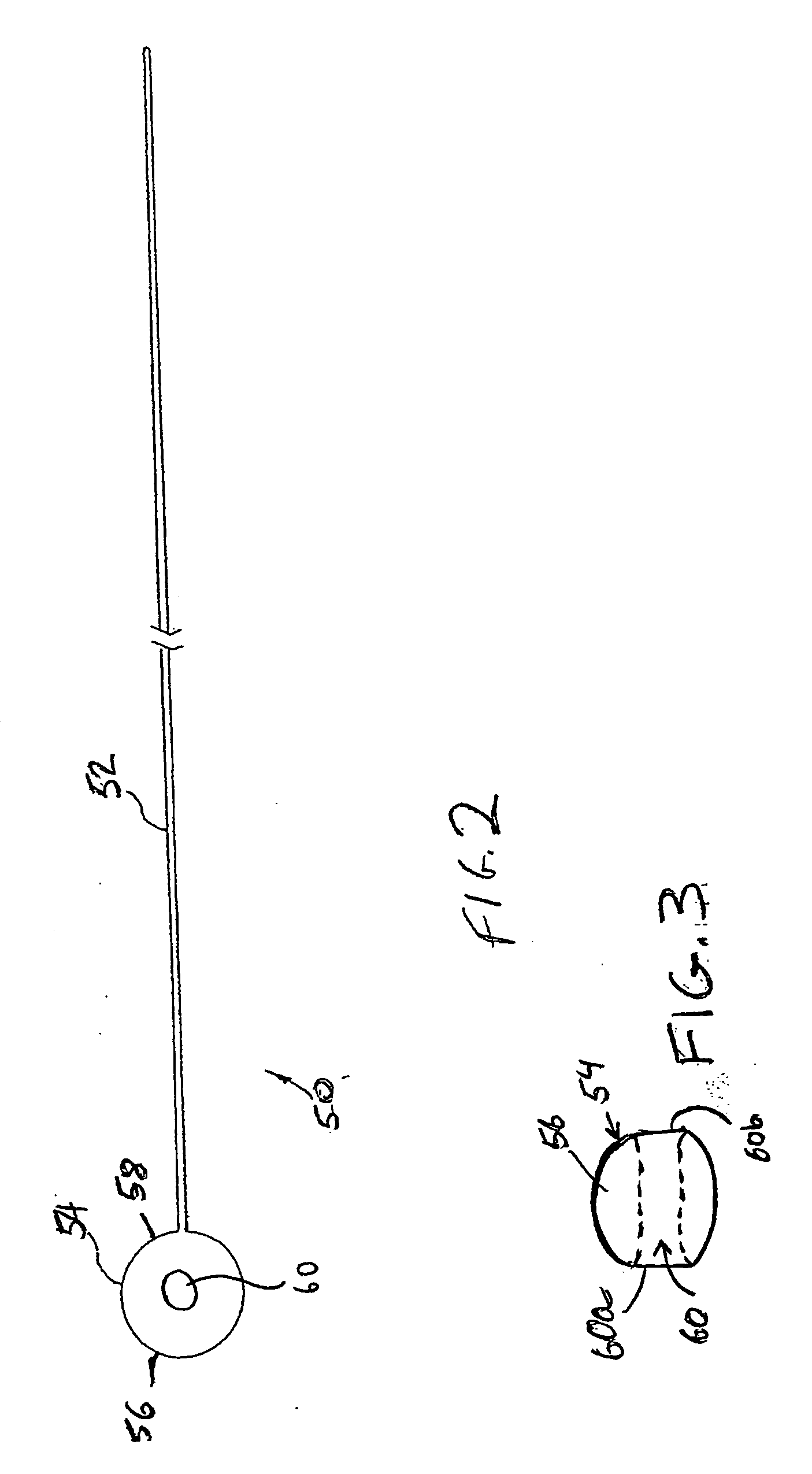Tubular apparatus for drainage of the colon and method and guidewire for colonic intubation
a technology of tubular apparatus and colon, which is applied in the field of colon drainage tubular apparatus, can solve the problems of ineffective evacuation of bacteria and gasses generated in the colon, drawbacks of each of these mechanisms and procedures, and inability to effectively evacuate bacteria and gasses, etc., and achieve the effect of preventing damage to the colon walls and easy feeling
- Summary
- Abstract
- Description
- Claims
- Application Information
AI Technical Summary
Benefits of technology
Problems solved by technology
Method used
Image
Examples
second embodiment
[0065]FIG. 4 shows a guidewire, designated 50a, having a shaft 52a having a substantially circular cross-section and which is tapered so that its diameter in proximity to the bulbous enlargement 54 is smaller than its diameter farther from the bulbous enlargement 54. This gives the guidewire 50a more flexibility near the bulbous enlargement 54, facilitating manipulation of the bulbous enlargement 54 and advancement through the bowel. Instead of a circular cross-section, the shaft 52a may have other cross-sectional shapes.
third embodiment
[0066]FIG. 5 shows a guidewire 50b having a shaft 52b which is constructed of a straight or tapering central metal core wire 62 surrounded by a wire coil 64. This configuration increases the diameter of the shaft 52b while maintaining the flexibility of the shaft 52b. The larger diameter of the shaft 52b allows for easier and safer handling of the guidewire 50b and makes it less likely to damage the wall of the bowel.
[0067] It is also conceivable to make the shaft 52 of the guidewire 50 of constant diameter throughout, but with the portion thereof attached to the bulbous enlargement 54 more flexible than the remainder of the shaft 52. For example, the flexibility of a segment of metal or plastic can be increased without altering its diameter. Another option is to form the shaft from a tapering metal core surrounded by a constant diameter coil.
[0068] Referring back to FIG. 1, after the guidewire 50 is situated in the colon with the bulbous enlargement 54 at the most proximal portion...
first embodiment
[0098] A first embodiment applying this alternative is shown diagrammatically in FIG. 15 wherein the drainage tube 72C has a main part 73 having a substantially uniform cross-section and a forward extension portion 90 of the drainage tube 72C passes through the cecal wall 76 and the abdominal wall 48. The forward extension portion 90 includes a channel communicating with the interior lumen in the main part 73. Apertures 74 are formed only in that portion of the drainage tube 72C that will be situated in the colon 70, i.e., the main part 73, and not in the forward extension portion 90 situated between the cecal wall 76 and the suction device 78.
[0099] The forward extension portion 90 of the drainage tube 72C can be coupled to a suction device 78. A rearward extension portion 75 of the drainage tube 72C includes a channel communicating with the interior lumen in the main part 73 and which is then left open to the ambient atmosphere. As such, the suction device 78 creates an air flow p...
PUM
 Login to View More
Login to View More Abstract
Description
Claims
Application Information
 Login to View More
Login to View More - R&D
- Intellectual Property
- Life Sciences
- Materials
- Tech Scout
- Unparalleled Data Quality
- Higher Quality Content
- 60% Fewer Hallucinations
Browse by: Latest US Patents, China's latest patents, Technical Efficacy Thesaurus, Application Domain, Technology Topic, Popular Technical Reports.
© 2025 PatSnap. All rights reserved.Legal|Privacy policy|Modern Slavery Act Transparency Statement|Sitemap|About US| Contact US: help@patsnap.com



